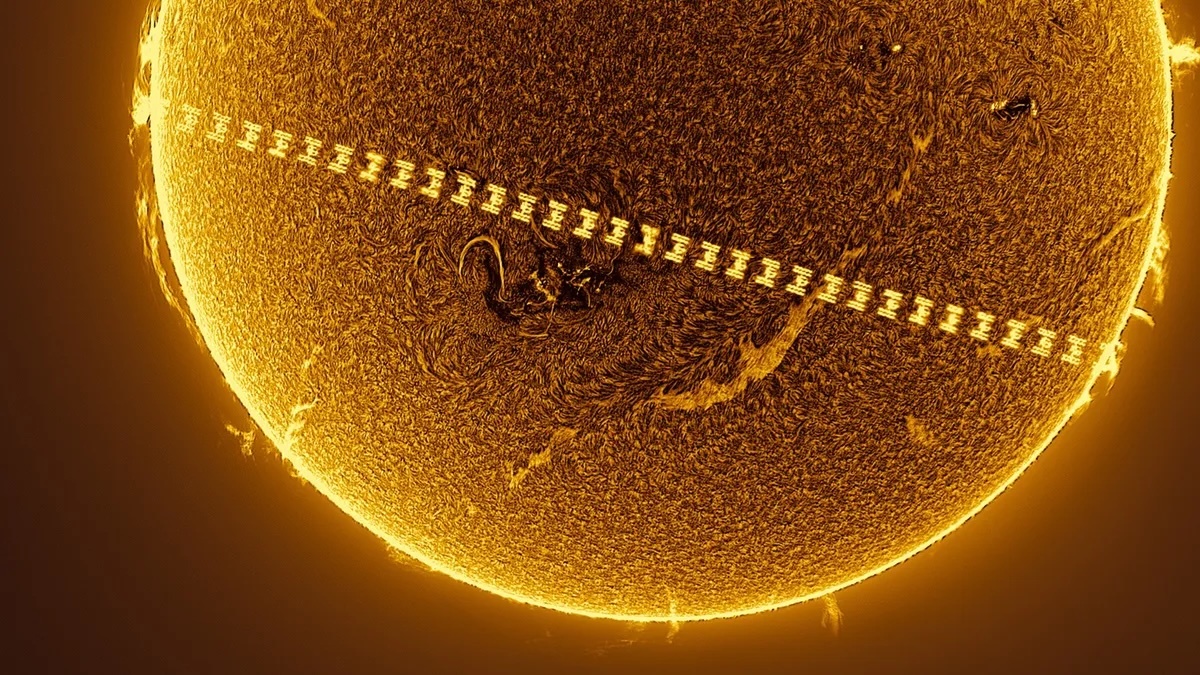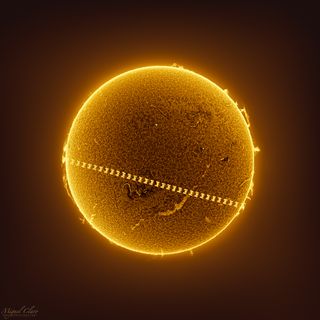2.07.2024
Astrophotographer Miguel Claro takes Space.com step-by-step through how such a breathtaking solar photo was made.

This image shows the silhouette of the International Space Station (ISS) as it crosses in front of the sun's disk (Image credit: Miguel Claro)
Miguel Claro is a professional photographer, author and science communicator based in Lisbon, Portugal, who creates spectacular images of the night sky. As a European Southern Observatory Photo Ambassador and member of The World At Night and the official astrophotographer of the Dark Sky Alqueva Reserve, he specializes in astronomical "Skyscapes" that connect both Earth and the night sky.
This image shows the silhouette of the International Space Station (ISS) as it crosses in front of the sun's disk at a distance of 274 miles (441.5 km) from us and at a speed of about 4.5 miles per second (7.31km/s).
Seen from Figueira da Foz on northern cost of Portugal on June 2, 2024, at 1:18 p.m. local time (1218 GMT), this transit had a total duration of only 0.54 seconds. The video shows a time-lapse of 200 images captured over the course of around 2 seconds.
The ISS transit across the sun was hard to see even with a special telescope equipped with hydrogen filters. I was only able capture this rare moment that happened in the blink of an eye with a fast video camera from Player One Astronomy, the Apollo-M Max, with its shutter set to an high speed frame rate of 109 images per second.
The images were processed individually without being stacked, and I was impressed with the quality achieved only with single frames. The ISS is visible in white on the first sequence, because of the inversion technique used to process the images of the sun's chromosphere with more depth. The second sequence shows the ISS in black without this inversion visible.

Its interesting that it's possible to recognize the distinct structures of the ISS in the photo, including its solar panels and modules. The image also shows in great detail jets of gas on the sun's outer atmosphere, a large gas filament and a large active region (or sunspot), as well as a few solar prominences around the sun's limb. With a diameter of 865,000 miles (1.4 million kilometers), our sun is composed of 73% hydrogen, 25% helium and 2% heavier elements
The ISS completes an entire orbit around Earth each 90-93 minutes. The orbital laboratory, home to an international crew of astronauts, spans some 358 feet (109 meters) in width. While fairly large in the sky with an angular diameter of 62.58", the ISS seems very small when compared with the massive size of the solar disc, which has an angular size of 31.6'. That makes the sun appear some 30.3 times larger than the ISS at the moment of this photo.
I hope you enjoy this photo as much as I do, and if you want to support my work as an independent artist, you can buy this image as a print and a piece of art or a wall decoration for your own home! Explore different sizing options and different print types below or contact me if you need further assistance. I'm planning to create a future limited edition Print Drop which will be available on my Print gallery. Meanwhile, you can sign-up my newsletter to get early access.
Editor's update 7/1: The transit had a total duration of 0.54 seconds, not 54 seconds. This article has been updated to reflect that.
Quelle: SC
